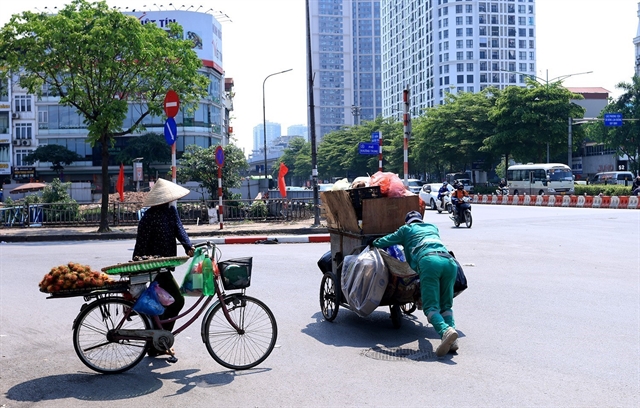 |
| Major cities like Hà Nội record the highest heat stress risks. — VNA/VNS Photo Tuấn Anh |
HÀ NỘI — Global warming is leading to heat stress that reduces productivity and causes adverse impacts on the economy, according to forecasts.
Occurring when the body is under stress due to overheating, heat stress, if mild, can affect a person’s performance and safety, but is not necessarily harmful to their health.
However, as the heat reaches human tolerance limits, the risks of heat-related disorders increase.
Developing countries are considered most susceptible to the negative effects of heat stress.
In response to a need for research on heat stress and its related meteorological factors in major cities to ensure public health, the Institute of Geography (under Việt Nam Academy of Science and Technology) has conducted a study in Hà Nội to assess heat stress index changes in the context of climate change.
The research also offers an initial evaluation of the link between heat-related diseases and key meteorological factors as well as the heat stress index, according to its lead author, Associate Professor Dr Hoàng Lưu Thu Thủy.
The study shows that Hà Nội has one of the highest heat stress risks, especially during the summer heatwaves.
This weather phenomenon likely leads to the ‘urban heat islands’, where a city’s infrastructure causes urbanised areas to experience higher temperatures than rural and mountainous regions.
Therefore, heat stress prevention measures are crucial for the period from May to September, with June and July in particular the two months with the highest heat stress indexes.
Amid climate change, the HI-max (maximum heat index) is forecast to increase every year from 2020 to 2050.
Accordingly, the number of days with an HI-max of 41 degrees Celsius (dangerous level) will witness a rising tendency between 2021 and 2050.
The lead author of the research Thủy added that during the months with high heat stress indexes, the human body may experience heat cramps or heat-induced exhaustion, as well as heat strokes due to prolonged exposure to high temperatures.
People living in areas more susceptible to heat stress must pay attention to health protection, especially for the more vulnerable groups such as the elderly and children.
Thủy also said that the human body’s adaptation to heat stress is limited, therefore, people should spend time resting to replenish their stamina and avoid working at full capacity in high-heat environments.
However, these are only temporary solutions, she noted, and the long-term vision should be to reduce and prevent heat stress effects on people’s health.
To do this, authorities need to revamp urban planning to make room for more open spaces and reduce air pollution by adding more parks, trees and lakes.
The study conducted by Thủy and her colleagues is expected to offer a scientific reference for future research on biometeorology, for higher education on bioclimatology and to inform people to ensure public health in a context where extreme heat waves and climate change are increasing.
Their work also provides initial evidence of the link between heat stress index and heat-related diseases.
However, for more objective and reliable assessments, Thủy suggested at least 30 years of data on health disorders related to heat stress index.
The research team plans to continue their study on human bioclimatology and help reduce climate change impacts on people’s lives. — VNS
- Reduce Hair Loss with PURA D’OR Gold Label Shampoo
- Castor Oil Has Made a “Huge” Difference With Hair and Brow Growth
- Excessive hair loss in men: Signs of illness that cannot be subjective
- Dịch Vụ SEO Website ở Los Angeles, CA: đưa trang web doanh nghiệp bạn lên top Google
- Nails Salon Sierra Madre
 VnExpress News The News Gateway of Vietnam
VnExpress News The News Gateway of Vietnam





